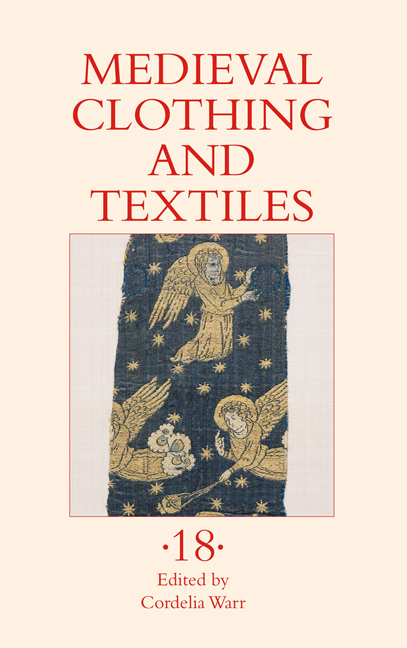Book contents
- Frontmatter
- Contents
- Illustrations
- Tables
- Contributors
- Preface
- 1 Linen Armour in the Frankish Countries: The Twelfth Century
- 2 Serial Production and Individualisation in Late Medieval Silk Weaving
- 3 The Trousseau of Isabella Bruce, Queen of Norway (The National Archives, Kew, DL 25/83)
- 4 Make and Create: The Craftswomen in the Salone Frescoes of the Palazzo della Ragione, Padua
- 5 Combs, Mirrors, and Other Female Beauty Bling in the Later Middle Ages
- 6 The Dividing Lines of Social Status in Sixteenth-Century Scottish Fashion
- Recent Books of Interest
- Author Index, Volumes 1–17
1 - Linen Armour in the Frankish Countries: The Twelfth Century
Published online by Cambridge University Press: 10 May 2024
- Frontmatter
- Contents
- Illustrations
- Tables
- Contributors
- Preface
- 1 Linen Armour in the Frankish Countries: The Twelfth Century
- 2 Serial Production and Individualisation in Late Medieval Silk Weaving
- 3 The Trousseau of Isabella Bruce, Queen of Norway (The National Archives, Kew, DL 25/83)
- 4 Make and Create: The Craftswomen in the Salone Frescoes of the Palazzo della Ragione, Padua
- 5 Combs, Mirrors, and Other Female Beauty Bling in the Later Middle Ages
- 6 The Dividing Lines of Social Status in Sixteenth-Century Scottish Fashion
- Recent Books of Interest
- Author Index, Volumes 1–17
Summary
While most kinds of armour appear in the archaeological record long before they can be identified with certainty in written evidence, the reverse is true for quilted armour in Western Europe. This appears in written sources from the twelfth century onwards, whereas the oldest surviving quilted garments and depictions of soldiers in quilted garments date to the thirteenth. Moreover, written sources give detailed lists
This is the first of a planned series of three articles on linen armour. Some of the research in this paper was supported by the Social Sciences and Humanities Research Council, Canada. of materials, information on construction techniques, prices, and other information that cannot be learned from art or the surviving artifacts. However, these texts are written in a wide variety of languages and call similar garments by a confusing variety of names. Medieval societies were multilingual, so it is necessary to study all languages spoken in a region to understand individual terms. Many terms could be used quite naturally in English, the Romance languages, and Latin. This project lays out the most important known sources from across Catholic Europe with translations, so that texts from the same country in different languages, and texts in the same language in different countries, can be studied side by side.
The sources discussed in this study are drawn from dictionaries (see Appendix 1.1 for a list), research on medieval armour, and reading by the author and fellow enthusiasts. Searchable digital corpora have been a very great help, but so have been the discussion forums and mailing lists of the 1998–2018 era where interested parties could pool their private lists of evidence. When selecting sources for inclusion, I have tried to represent as many languages and regions as possible and preferred sources with technical information to sources which simply mention a gambeson, pourpoint, or aketon. Unless otherwise indicated, translations are my own.
TERMS DISCUSSED
In Western Europe before the Fourth Crusade (1202–4), five families of words can refer to a quilted coat. (For words for quilted garments, see table 1.1.) Aketon, gambais/ gambeson, and pourpoint are relatively easy to interpret, although aketon can also refer to cotton fibre or to cotton cloth (see sources ii.2, ii.9, ii.10, ii.13, below); the etymology of gambeson is disputed; and pourpoint can be anything which is quilted, such as a bedcover or horse cover. Words in the jupe family are more difficult to interpret.
- Type
- Chapter
- Information
- Medieval Clothing and Textiles , pp. 1 - 40Publisher: Boydell & BrewerPrint publication year: 2024



